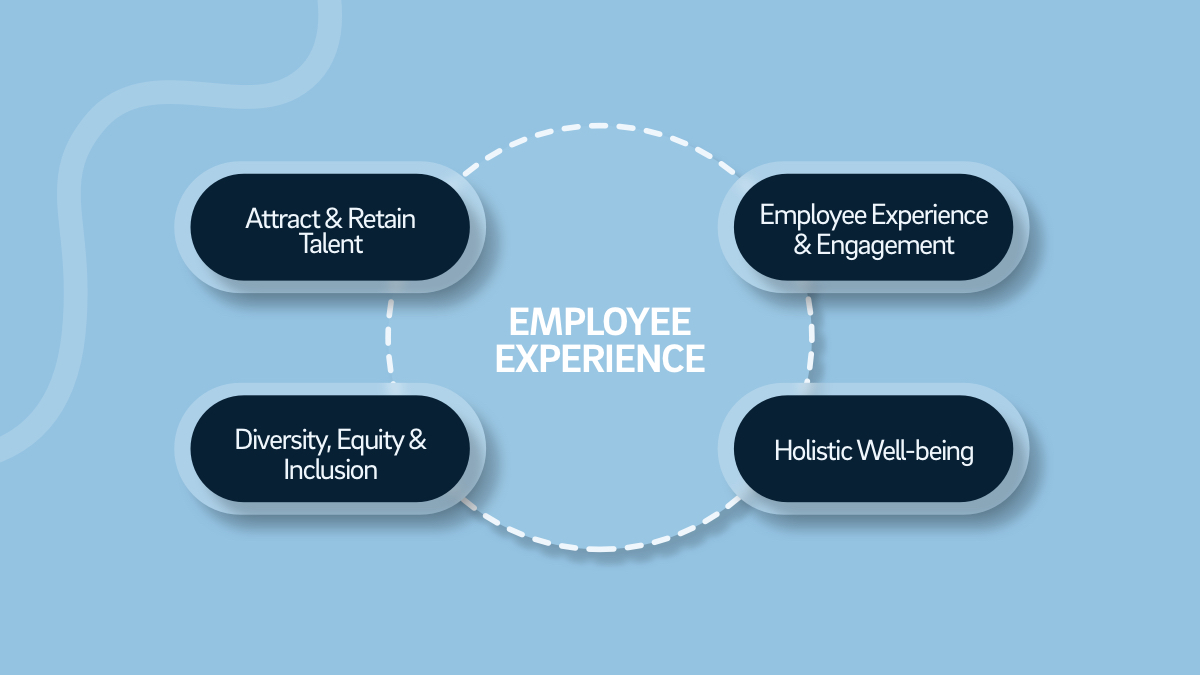4 Ways to Drive the Employee Experience in 2022
Rebecca Morris

The past two years have been pivotal for businesses and HR leaders. Continued health, economic, and financial uncertainty brought on by the pandemic has led many employees to reevaluate their priorities, with record numbers choosing to leave their jobs in search of something new or more meaningful. The war for talent spurred by this “Great Reckoning”, along with an increased incidence of employee stress and burnout, has forced employers to reassess their culture, benefits, and work environment and to think deeply about how they can better support the needs of their workforce.
It’s imperative that employers and leaders continue to look for ways to put their people first. Companies that recognize the core challenges outlined below, and can turn them into opportunities to drive the employee experience, will lead the way forward in the future of work.
1. Attracting & Retaining Talent
COVID-19 led many employees to reassess what’s most important—both at work and in their personal lives. While it’s true that some searched for jobs with higher pay, others left for companies with similar values, or a work environment that better aligns with their lifestyle. Companies can demonstrate their commitment to their people and better attract and retain talent by fostering a positive work environment and offering the right mix of Total Rewards. 30% of employees surveyed in the BrightPlan 2021 Wellness Barometer Survey said that enhanced benefits would make them more committed and more likely to stay with their employer. In addition, support, specifically for financial wellness, has a direct impact on retention. The 2021 PwC Financial Wellness survey revealed that 72% of employees stressed about their finances would leave for another company that cares more about their financial well-being.
2. Employee Experience & Engagement
Whether employees are working remotely or in the office, keeping them engaged is a challenge that has direct impacts on the bottom line. According to Gallup’s State of the American Workplace report, highly engaged business units see a 41% reduction in absenteeism and a 17% increase in productivity, translating to 21% greater profitability.
Always listen to how your employees are feeling about their job and work environment. Conduct pulse surveys regularly and make adjustments to your benefits, policies, and programs accordingly.
3. Holistic Well-being
Holistic well-being recognizes the need to care for the “whole person,” including their physical, mental, financial and social well-being. Supporting employees holistically is rooted in the understanding that all aspects of well-being affect employees’ overall health. The Kaiser Family Foundation found that 53% of U.S. adults say financial stress related to the coronavirus has hurt their mental health, and Northwestern University found that U.S. adults between 24-32 years with high debt, had higher diastolic blood pressure.
An employee experience that prioritizes holistic wellness, such as mental health, caregiver support, and financial well-being can help employees live a balanced life and achieve important career and personal goals.
4. Diversity, Equity and Inclusion
As the racial justice movement made inequities and biases more visible, many companies are not just talking about these challenges but are taking deliberate actions to influence systemic and lasting change. Diversity, equity, and inclusion (DE&I) initiatives envision a level playing field for underrepresented employees in the pursuit of physical, mental and financial well-being.
Financial wellness is a core part of DE&I. Consider these inequities in financial wellness, which vary greatly according to gender, income, race and access to education:
- 58% of Black and Latino households don’t have enough savings to cover three months of expenses at the federal poverty rate.
- Women are 10% less likely than men to invest for their goals.
- Just 3.9% of students from low-income schools have access to financial education, compared to 17% nationwide.
A holistic Total Rewards approach is a strategic way to address inequities in compensation and benefits. While organizations work to eliminate pay disparities, they can significantly advance their DE&I agendas with high-value benefits and support structures, such as Employee Resource Groups, that address the needs of their entire employee population.
In the midst of accelerated change in why, how, where and when people work, companies must find ways to create more meaningful and lasting emotional connections with their employees, or they will end up on the losing side of the war for talent.
Learn more about BrightPlan’s strategy and solutions for supporting HR and business leaders’ top challenges.



